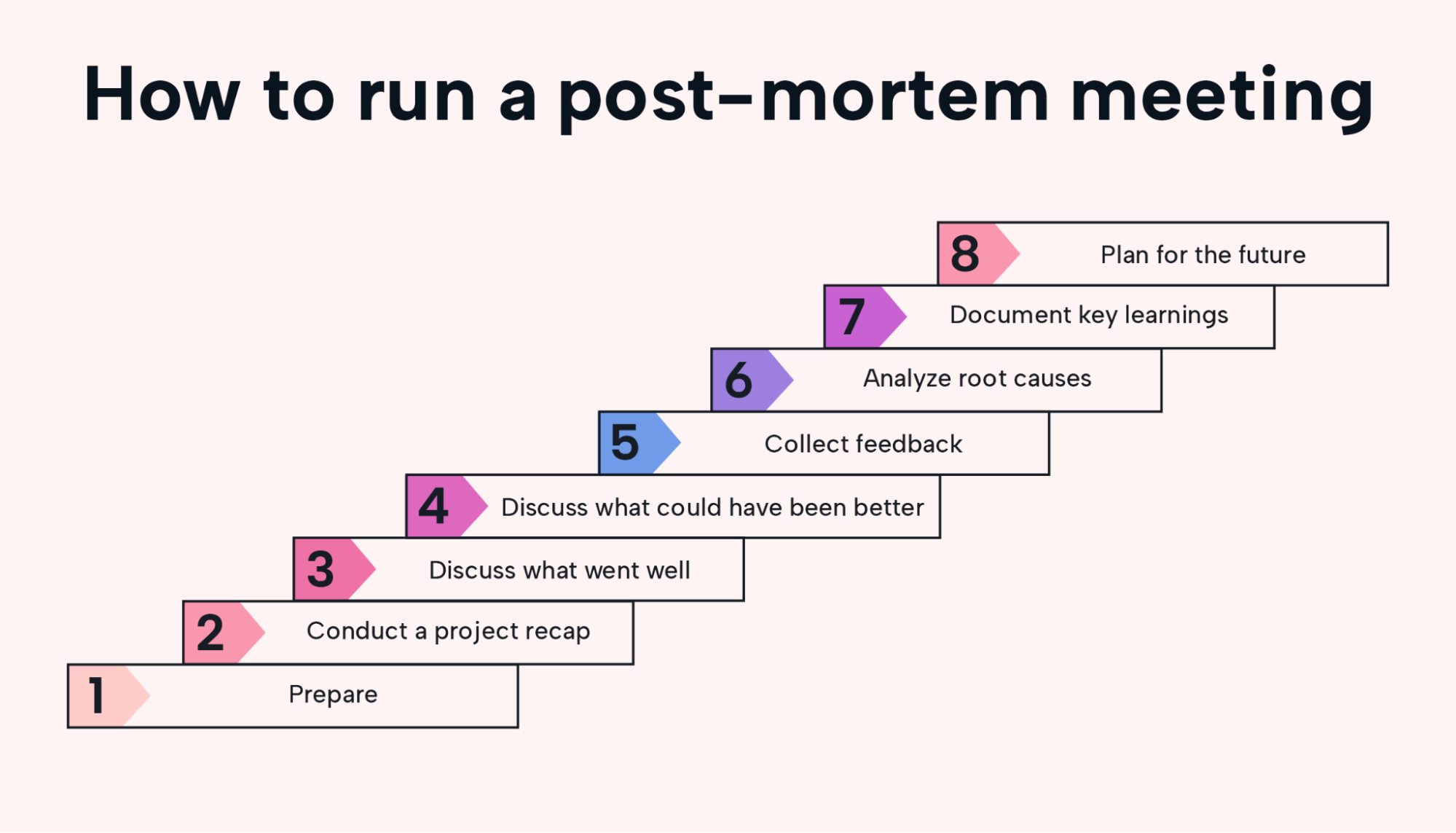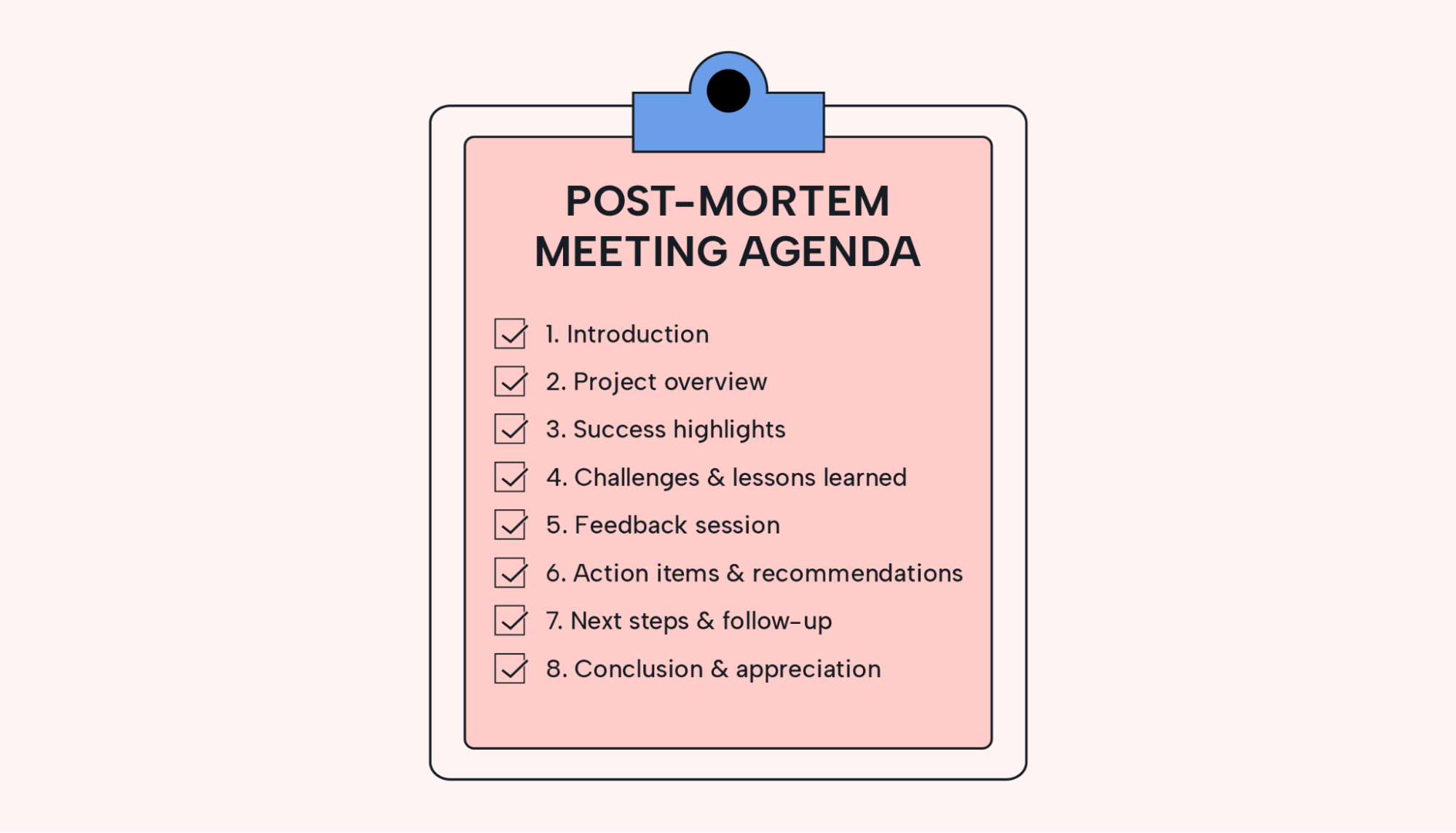Ever finished a big project and thought, “Phew, I’m glad that’s over!”?
Well, in the world of project management, things don’t quite end with the final deliverable. Before moving on to the next adventure, there’s a crucial pit stop: the post-mortem meeting.
But don’t worry — it’s not as grim as it sounds. A post-mortem meeting aims to identify project successes, challenges, and areas for improvement, offering teams a structured way to evaluate their efforts and plan for the future.
Curious to learn more about the ins and outs of post-mortem meetings? We delve into the specifics of what these sessions involve and how you can hold successful ones with your team.
What is a post-mortem meeting?
A post-mortem meeting is a discussion held after a project is finished. Participants go over what went well, what went wrong, and what can be learned for the next project. It includes everyone who was involved in the project.
This meeting is not just a simple wrap-up but a focused analysis to help the team really understand how the project went and how to improve in the future.
Questions to ask during post-mortem meetings
During a post-mortem meeting, asking the right questions is crucial to helping the team understand their project performance and come up with actionable insights for future projects.
Here are some questions to consider asking:
- What were the original goals of the project, and were they achieved?
- What went well during the project?
- What didn’t go well during the project?
- Were there any unexpected project obstacles or challenges? How were they handled?
- Did the project stay on schedule and within budget? If not, why?
- Were the right resources and tools available and utilized efficiently?
- Was communication among the team and with stakeholders effective?
- What could be done differently to improve the project outcomes?
- What have we learned from this project that can be applied to future ones?
- How well did the team work together? Did any interpersonal issues arise that impacted the project?
Who should attend a post-mortem meeting?
The attendees of post-mortem meetings often include the following:
- Project team members
- Project managers
- Stakeholders
- Representatives from supporting teams (e.g., IT or HR)
- Senior management (if necessary)
 |
Ideally, everyone who was involved in the project should attend the project’s post-mortem meeting. This will help ensure that the entire team understands the outcomes from multiple perspectives.
Why hold a post-mortem meeting?
Holding a post-mortem meeting after completing a project is important for the following reasons:
To identify successes
Recognizing what went well in the project is crucial during a post-mortem meeting. That way, the team can replicate these things to enable future projects’ success. Celebrating successes is also a great way to boost the team’s morale.
To share experiences and knowledge
Post-mortem meetings foster a culture of knowledge-sharing among teams. When team members discuss their mistakes and how they fixed them, others can learn how to handle — or even outright avoid — similar situations in the future.
Likewise, if something went really well in the project, this is the time to share it. Others can learn from these success stories and perhaps use the same good ideas in their next projects.
To ensure open communication
A post-mortem meeting creates a space for open dialogue where team members can share their thoughts, experiences, and feedback about the project in a structured manner. Talking openly and honestly about the project helps ensure everyone on the team is on the same page, making them stronger for future projects.
For closure
A post-mortem meeting acts as a summary of all the activities, achievements, and challenges the team faced during the project. As such, this wrap-up gives the team a sense of closure. This acknowledgment helps the team members move on to new tasks.
How to run a post-mortem meeting
You already know that conducting a post-mortem meeting is important, but how do you actually go about holding one? Follow the steps below to ensure your post-mortem meeting with your team is a great one.
 |
1. Prepare
- Schedule the meeting. Ideally, the post-mortem meeting should be held soon after the project’s completion — while the memories are still fresh.
- Use Motion’s meeting scheduler to help you pick a date that’s suitable and ensure that everyone you want to invite is available.
- Invite the relevant stakeholders. This includes team members, project managers, and any other individuals who played a significant role in the project.
- Designate a meeting facilitator. It may be helpful to include a neutral party in the post-mortem who can keep the discussion on track and ensure all voices are heard. This person could be an external facilitator or someone within the organization who wasn’t directly involved in the project.
- Set the agenda. Clearly outline what will be discussed during the meeting.
2. Conduct a project recap
- Revisit the project’s initial objectives and scope. Discuss whether the objectives were met, exceeded, or unmet. If there were any changes in scope during the project, this would be a good time to discuss and understand the reasons behind them.
- Review the deliverables. Discuss the deliverables’ quality and effectiveness and compare them against what was initially proposed.
- Use data and metrics. If possible, present the data and metrics to provide a clear and unbiased view of the project’s performance against its objectives.
3. Discuss what went well
- Identify the project’s successes. Reflect on the positive aspects and successes of the project. This is an opportunity to acknowledge and celebrate the team’s achievements, which can reinforce a positive culture.
- Recognize and celebrate the team members. Highlight individual team members’ contributions, especially those who went above and beyond to ensure project success. Make special mentions of innovative solutions, challenging situations that were handled well, outstanding leadership, and any other noteworthy efforts that were made.
4. Discuss what could have gone better
- Talk about the challenges the team faced. Everyone shared in the tough parts of the project, like delays or unexpected problems. So, talk about why these things happened.
- Keep in mind that it’s important that no one blames others during this time. The focus should be on learning, not pointing fingers.
- Suggest ways to do better in the future. Stay positive, and look forward to doing better next time. Future improvements could include new project management tools or better communication.
5. Collect feedback
- Use tools or software. Gather anonymous feedback before the meeting. This helps ensure all voices — especially those from team members who might be hesitant to speak up — are heard.
- Ensure an open floor. Allow the team members to share their observations and experiences.
- Motion’s collaborative features make it easier for team members to share their insights, feedback, and suggestions for future projects.
6. Analyze root causes
- Dive deep. Conduct an in-depth analysis of significant project challenges or mistakes to understand their root causes. This will help the team come up with ways to avoid such issues in the future.
- Use root-cause techniques. Frameworks like the “5 Whys” can be beneficial. This technique involves asking the question “Why?” repeatedly to drill down to a problem’s root cause.
7. Document key learnings
- Record key learnings. These can include successes, challenges, or suggestions for improvement.

- Develop a standard template for documenting post-mortems. This will help ensure consistency across projects.
- Create a centralized repository for post-mortem documents. These notes can be invaluable for future projects.
8. Plan for the future
- Establish action items. Discuss how the team can implement the learnings from the post-mortem into future projects.
- Assign responsibility. Delegate specific action items to ensure they are executed.
- Draw up an implementation timeline. Use this timeline to help the team know when tasks or new processes should be implemented.
Post-mortem meeting do’s and don’ts
There are a number of do’s and don’ts that will help ensure your post-mortem meetings are effective and constructive.
Do’s
Here’s what you should do during a post-mortem meeting:
1. Prepare in advance
- Send out an agenda or a list of discussion points.
- Ask the team members to think about the feedback they’ll offer ahead of time.
2. Create a safe environment
- Emphasize that the meeting is a blame-free zone.
- Encourage open and honest communication.
3. Start with the positives
- Begin by discussing what went well to set a positive tone for the rest of the meeting.
4. Follow up
- Revisit the action items in the next project or sprint to ensure they’re being implemented.
5. Keep the meeting time-bound
- Have a set start and end time to help keep the meeting focused.
Don’ts
Here’s what not to do during a post-mortem meeting:
1. Don’t place blame
- The goal is to identify areas of improvement, not to point fingers.
2. Don’t get defensive
- If you’re receiving feedback, actively listen without becoming defensive.
3. Don’t let one voice dominate
- Ensure everyone has an opportunity to speak and share their perspectives.
4. Don’t make the meeting personal
- Focus on processes, tools, and outcomes, not the team members’ personal attributes or characteristics.
5. Don’t forget to act
- The meeting won’t be effective if the team doesn’t implement the improvements the meeting helped you identify.
Post-mortem meeting agenda template
A post-mortem meeting agenda should be structured to facilitate a thorough and constructive discussion about the project. Here’s an example of a post-mortem meeting agenda:
 |
1. Introduction (5 minutes)
Objective: To set the tone for the meeting.
Activities:
- Hold a brief overview of the post-mortem meeting’s purpose.
- Reiterate that the focus is on constructive feedback and learning.
2. Project overview (10 minutes)
Objective: To refresh the team’s memory of the project.
Activities:
- Briefly recap the project goals and objectives.
- Highlight the project timeline and milestones.
3. Success highlights (15 minutes)
Objective: To recognize — and reinforce — what went well.
Activities:
- Share statistics or metrics showcasing the project’s successes.
- Allow the team members to share positive experiences or outcomes.
4. Challenges and lessons learned (25 minutes)
Objective: To discuss what didn’t go as planned and how to improve.
Activities:
- Have an open discussion about the challenges faced.
- Identify the root causes of any major issues that arose.
- Discuss the lessons learned and how to avoid similar challenges in the future.
5. Feedback session (25 minutes)
Objective: To allow the team members to share their perspectives.
Activities:
- Allow each team member to provide feedback on the following:
- What they felt went well
- Where improvements could be made
- Suggestions for future projects
6. Action items and recommendations (20 minutes)
Objective: To translate the discussion into actionable steps for improvement.
Activities:
- List proposed improvements or changes that should be made to future projects.
- Assign responsibility for each action item.
- Set deadlines or timelines for these tasks.
7. Next steps and follow-up (10 minutes)
Objective: To ensure continuity and accountability.
Activities:
- Schedule a follow-up meeting if necessary.
- Discuss how to implement and monitor the action items.
- Determine how the feedback will be incorporated into future projects.
8. Conclusion and appreciation (5 minutes)
Objective: To close the meeting on a positive note.
Activities:
- Thank everyone for their participation and contributions.
- Emphasize the value of continuous learning and improvement.
Turn reflections into action with Motion
A post-mortem meeting is an opportunity for the team to come together to reflect on their project journey. However, reflections alone won’t propel a project forward; it’s the action steered by those insights that truly counts.
Motion is your ally for turning these post-project reflections into actionable steps. With it, you can effortlessly transition from discussing key learnings to implementing them in your next project. You can track tasks, deadlines, and responsibilities stemming from your post-mortem discussions in one consolidated place.
Plus, Motion’s intuitive interface allows for seamless assignment of tasks, ensuring that the solutions and strategies born from your reflections are well on their route to execution.
Ready to turn those post-mortem reflections into tangible progress? Motion is poised to become an integral part of your project’s journey toward continuous improvement.





